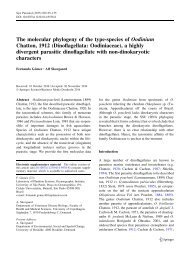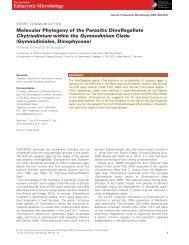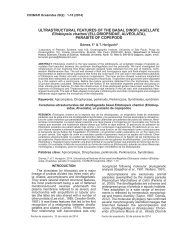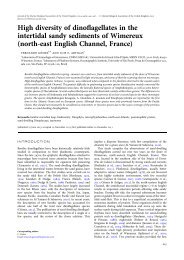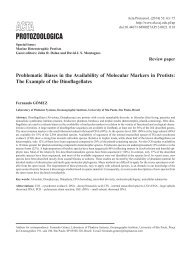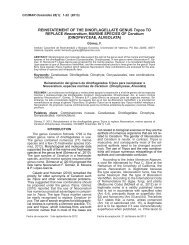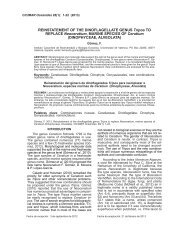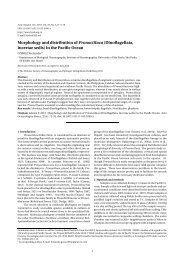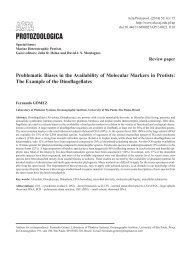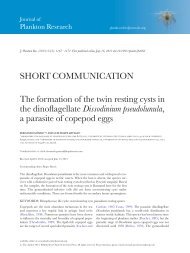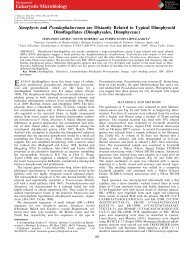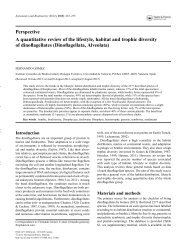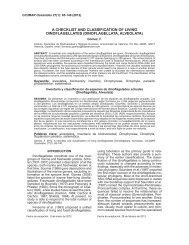Solenicola setigera is the first characterized memberof the abundant and cosmopolitan uncultured marine stramenopile group MAST-3
Culture-independent molecular methods based on the amplification, cloning and sequencing of smallsubunit (SSU) rRNA genes are a powerful tool to study the diversity of prokaryotic and eukaryotic microorganisms for which morphological features are not conspicuous. In recent years, molecular data from environmental surveys have revealed several clades of protists lacking cultured and/or described members. Among them are various clades of marine stramenopiles (heterokonts), which are thought to play an essential ecological role as grazers, being abundant and distributed in oceans worldwide. In this work, we show that Solenicola setigera, a distinctive widespread colonial marine protist, is a member of the environmental clade MArine STramenopile 3 (MAST-3). Solenicola is generally considered as a parasite or an epiphyte of the diatom Leptocylindrus mediterraneus. So far, the ultrastructural, morphological and ecological data available were insufficient to elucidate its phylogenetic position, even at the division or class level. We determined SSU rRNA gene sequences of S. setigera specimens sampled from different locations and seasons in the type locality, the Gulf of Lions, France. They were closely related, though not identical, which, together with morphological differences under electron microscopy, suggest the occurrence of several species. Solenicola sequences were well nested within the MAST-3 clade in phylogenetic trees. Since Solenicola is the first identified member of this abundant marine clade, we propose the name Solenicolida for the MAST-3 phylogenetic group.
Culture-independent molecular methods based on
the amplification, cloning and sequencing of smallsubunit
(SSU) rRNA genes are a powerful tool to
study the diversity of prokaryotic and eukaryotic
microorganisms for which morphological features are
not conspicuous. In recent years, molecular data from
environmental surveys have revealed several clades
of protists lacking cultured and/or described
members. Among them are various clades of marine
stramenopiles (heterokonts), which are thought to
play an essential ecological role as grazers, being
abundant and distributed in oceans worldwide. In this
work, we show that Solenicola setigera, a distinctive
widespread colonial marine protist, is a member of
the environmental clade MArine STramenopile 3
(MAST-3). Solenicola is generally considered as a
parasite or an epiphyte of the diatom Leptocylindrus
mediterraneus. So far, the ultrastructural, morphological
and ecological data available were insufficient
to elucidate its phylogenetic position, even at the division
or class level. We determined SSU rRNA gene
sequences of S. setigera specimens sampled from
different locations and seasons in the type locality,
the Gulf of Lions, France. They were closely related,
though not identical, which, together with morphological
differences under electron microscopy,
suggest the occurrence of several species. Solenicola
sequences were well nested within the MAST-3
clade in phylogenetic trees. Since Solenicola is the
first identified member of this abundant marine clade,
we propose the name Solenicolida for the MAST-3
phylogenetic group.
You also want an ePaper? Increase the reach of your titles
YUMPU automatically turns print PDFs into web optimized ePapers that Google loves.
<strong>Solenicola</strong> belongs to <strong>uncultured</strong> <strong>stramenopile</strong>s <strong>MAST</strong>-3 195<br />
Fig. 1. Light micrographs of live colonies of <strong>Solenicola</strong> <strong>setigera</strong>.<br />
A–D. The colonies collected for SSU rDNA analys<strong>is</strong> were (A) S. <strong>setigera</strong> FG11 from Marseille, winter, (B) S. <strong>setigera</strong> FG174 from Marseille,<br />
spring, <strong>and</strong> (C <strong>and</strong> D) S. <strong>setigera</strong> FG711 from Banyuls, spring. (D) Siliceous tube after <strong>the</strong> detachment of <strong>Solenicola</strong>.<br />
E <strong>and</strong> F. Colony partially covered of an unusual green<strong>is</strong>h pigmentation (see also Video S2). (F) Note <strong>the</strong> spots of orange-yellow fluorescence<br />
under green light excitation, tentatively ingested cyanobacteria or photosyn<strong>the</strong>tic picoeukaryotes. For compar<strong>is</strong>on, <strong>the</strong> bigger red spot<br />
corresponds to a diatom (Chaetoceros). <strong>Solenicola</strong> cells did not show chlorophyll a autofluorescence when excited by ei<strong>the</strong>r blue or green<br />
light.<br />
G. Individuals of <strong>Solenicola</strong> detaching from <strong>the</strong> siliceous tube after <strong>the</strong> manipulation.<br />
H–J. Several colonies showing <strong>the</strong> d<strong>is</strong>position of <strong>the</strong> flagella.<br />
Scale bars 10 mm.<br />
late spring. At Marseille, 85, 120 <strong>and</strong> 20 colonies were<br />
observed in November, December 2007 <strong>and</strong> January<br />
2008 respectively. The species reappeared in May (10<br />
colonies), June (40 colonies) <strong>and</strong> September 2008 (10<br />
colonies). At Banyuls sur Mer, 60 <strong>and</strong> 150 colonies were<br />
observed, respectively, in November <strong>and</strong> December of<br />
2008. The species reappeared in May (5 colonies) <strong>and</strong><br />
June 2009 (50 colonies). We collected several colonies<br />
for fur<strong>the</strong>r observation by electron microscopy <strong>and</strong> amplification<br />
of SSU rDNA, <strong>the</strong> sequence of which was successfully<br />
determined (see below) for <strong>the</strong> three following<br />
colonies: FG11, collected from <strong>the</strong> coast of Marseille on<br />
22 December 2007 (Fig. 1A), FG174, collected on 16<br />
June 2008 in <strong>the</strong> same locality (Fig. 1B), <strong>and</strong> FG711 from<br />
coastal waters of Banyuls sur Mer on 15 June 2009<br />
(Fig. 1C <strong>and</strong> D).<br />
The individuals of <strong>Solenicola</strong> formed clusters on <strong>the</strong><br />
surface of siliceous tubes usually interpreted as frustules<br />
of chain-forming diatoms (Fig. 1A–J). <strong>Solenicola</strong> cells<br />
could entirely cover <strong>the</strong> siliceous tube (Fig. 1A <strong>and</strong> E) or<br />
be forming clusters in localized areas along <strong>the</strong> tube<br />
(Fig. 1C, I <strong>and</strong> J). The individual <strong>Solenicola</strong> cells were<br />
4–7 mm long <strong>and</strong>, under optical microscopy, globular or<br />
tear-shaped. When v<strong>is</strong>ible, cells possessed a single flagellum<br />
of variable length, sometimes up to 24 mm long. In<br />
living colonies, <strong>the</strong> flagella beat perpendicularly to <strong>the</strong><br />
© 2010 Society for Applied Microbiology <strong>and</strong> Blackwell Publ<strong>is</strong>hing Ltd, Environmental Microbiology, 13, 193–202



